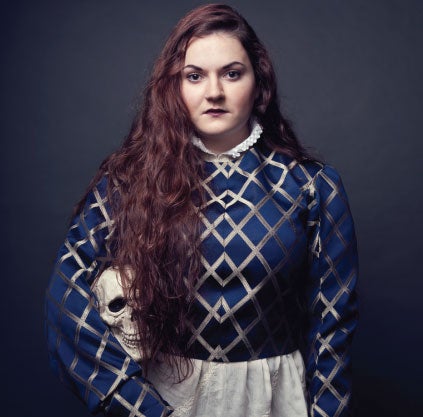The outburst isn’t fooling anyone. Everyone can see exactly what’s going on here: ’Tis unmanly grief: Hamlet is acting like a girl.
When Shakespeare wrote Hamlet, he swathed his protagonist in so much internal and dramatic conflict, the irony of the attitudes toward gender roles is enough to get through even the thickest skulls in the churchyard. Of course, it only gets more obvious in today’s social context – especially, as Darien Bucher discovered, when Hamlet is played by a female.
Bucher, a senior majoring in English, stumbled upon her first female Hamlet in a 1921 German silent film while studying in Ireland. The actress was Asta Nielsen, and she was the best Hamlet Bucher had ever seen.
“It was striking. She really was Hamlet!” says Bucher, who has been a Shakespeare junkie ever since she read Romeo and Juliet in eighth grade. It was Shakespeare, in fact, who swayed her academic focus from theater to English. “Shakespeare is where it all comes together. It is the meeting point between literature and theater. The middle ground. It is literature that is meant to be performed and interpreted for the stage. It suits me perfectly.”
And so does her senior thesis topic: females portraying Hamlet.
“As a woman who’s interested in theater, it mattered to me that I try to understand what the female perspective of Hamlet has been and how it might continue now, especially since nontraditional casting has become a popular phenomenon,” says Bucher, whose first order of business was tracking down other female Hamlets.
That, it turned out, was the easy part.
“It’s actually a pretty established tradition starting as early as the mid-18th century,” she says, noting that female Hamlets are more common in theater than in film. “Especially for unknown actresses in the 19th century, this was a way to prove their worth. Because there weren’t a lot of opportunities for women to prove their acting skills, you see a lot of budding actresses starting out in this role at that time.”
For the amount of female Hamlets out there, however, Bucher found a surprising lack of academic research.
“There just isn’t much scholarship about women who have taken up the most famous role in Western drama and what they have been trying to say about a woman’s role in both theatrical society and the wider world stage,” says Bucher, whose research focuses primarily on the silent German film and a 1976 Turkish film that speaks to women’s roles there.
“That was a pivotal one because women were so oppressed in that culture. The actress makes the most of the voice she’s given in that role, scorning violence against women,” says Bucher, explaining that, instead of ending with the stabbing, “the last image is the female Hamlet destroying violence and potentially the patriarchy. It sort of appropriates the story, because it doesn’t end in death.”
Bucher has found a lot of variation in females’ portrayals of Hamlet, but, she says, “Most of them want to do it for a reason. They had something to prove. They wanted to show, ‘This is what women’s lives are like.’”
And now Bucher is showing their perspective again.
“I’m grateful to have had the opportunity to delve into a sort of dark-side-of-the-moon aspect of Hamlet studies that really deserves to see the light of day,” she says. “I’m also perhaps fostering a hope that I can be that female Hamlet one day, especially knowing now how the tradition has moved through history and how much can be said with Shakespeare’s text that applies today.”
And what, exactly, would she bring to the role of Hamlet?
“An understanding of his grief and how it affects his indecision. His actions and lack thereof are all manifestations of that grief – I would want to show that.”
Together with all forms, moods, shapes of grief
That can denote me truly: these indeed seem,
For they are actions that a man might play.
Or, in this case, a woman.






